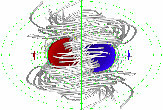Origin of Earth's Magnetic Core Remains a Mystery

If compasses were around a million years ago, they would not have pointed toward North. That's because the Earth's magnetic field likely underwent a reversal 800,000 years ago, explains Daniel Lathrop, a geophysicist at the University of Maryland. This is hardly a startling idea to scientists, but experts have long lacked a convincing way to be sure because the answer probably lies at Earth's core. Starting at somewhere around 2,000 to 3,000 miles from the surface, Earth's molten upper core is a challenging observational target. But with better measurements of the turbulent motion of molten iron there, scientists hope to learn what is responsible for processes related to the origins of the Earth's magnetic field and the occasional flip-flops that take place. The magnetic field and its orientation at any time in Earth's history has had big consequences for life. It protects us from electromagnetic radiation from space. And many animals, including some birds, rely on magnetic forces to navigate. Although the reversal back in the Pleistocene Epoch does not appear to have caused mass extinctions, the effects of a future reversal are unknown. "We'd like to understand how to predict changes in the future," said Lathrop. "The magnetic field's strength has fallen 10 percent in last 160 years and continues to fall. This could be a sign we're headed toward a reversal, but we just don't know." Lathrop is one of a handful of scientists who have started to work with new computer models of the hot liquid metals flowing deep in the Earth's core. Researchers in laboratories in the United States, France and Russia are putting the simulations to work, to replicate the Earth's magnetic field more realistically than ever before. "The simulations give a lot more data of the internal structure of flowing liquid metals," Lathrop said. "Normally, you can only measure a handful of points, but with a computer simulation you get information about what's going on at all of the locations inside." And the simulations are providing geologists and physicists with their clearest picture ever of the genesis of the planet's magnetic field. According to the widely accepted "magnetic-dynamo theory," Earth's magnetic field is created by the turbulent motion of electrically conductive fluid, most of which is iron. However, since these interactions occur deep within the Earth, measuring and observing them directly is almost impossible. The simulations, developed by applied physicist Sasa Kenjeres and Kemal Hanjalic of Delft University of Technology in the Netherlands and detailed in the March 6 issue of the journal Physical Review of Letters, show that a highly turbulent swirling motion of liquid can produce and self-sustain a magnetic field. "Our knowledge of the existing magnetic fields is quite advanced, but the crucial question is how magnetic fields—for example in spiral galaxies, stars and planets—are created in the first place," said. "The main reason for this mystery is in its complexity."
- Top Ten Unexplained Phenomena
- 101 Amazing Earth Facts
- Bird Radar
Sign up for the Live Science daily newsletter now
Get the world’s most fascinating discoveries delivered straight to your inbox.









